The role of Pontormo ’s (Jacopo Carucci; Pontorme di Empoli, 1494 - Florence, 1557) Deposition as the founding masterpiece of the historical period that is called “Mannerism” in the manuals is now acknowledged, despite the fact that the work can also (and perhaps above all) be read as a chapter in itself, as the fruit of the ingenuity of an artist who, although a child of his time, cannot be pigeonholed and is exceedingly difficult to categorize. The painting, commissioned from the extravagant Empolese artist in 1525 by the banker Ludovico Capponi for the newly acquired family chapel in the church of Santa Felicita in Florence, was ready in 1528 when it reached the Capponi chapel, which was further decorated by the artist with a God the Father in the small dome (now lost), and with roundels of the four evangelists, made together with Bronzino, in the pendentives (as far as we can reconstruct on stylistic grounds, Pontormo took care of the St. John and left the others to his very young pupil).
We still see the Deposition in the place for which it was intended, and moreover within the original frame, fine work by Baccio d’Agnolo. Giorgio Vasari relates that during the stages of the work, Pontormo wanted no one, for any reason, to see the painting. Not even the patron was allowed to peek at the work as it took shape. And so, “having done it in his own way, without any of his friends being able to warn him of anything,” Vasari writes, “it was finally with marvel of all Florence discovered and seen.” Vasari’s judgment was not positive: by “marvel” he meant a feeling more akin to bewilderment than pleasant surprise.
And we can indeed imagine the wonder of the Florentines before a work that subverted all schemes, in stark contrast to tradition, which denied all norms of measure and balance. Pontormo’s composition lacks, first of all, any spatial reference: there is no landscape, in the Deposition of the Capponi Chapel, but there are only figures occupying every free portion of the surface of the panel, except for a tiny piece of sky on the left where a cloud is observed. The figures appear light, evanescent, seeming almost to fly through space. The viewer’s gaze focuses on the farewell of the Virgin, whom we see on the right as she moves her hand toward her son supported by two young men, perhaps two angels, to greet him one last time. Above her is the figure of mourning Saint John, spreading his arms wide in despair. To the side, at the apex of this human pyramid, stands a woman of no easy identification, standing upright, looking down: even for her it is not clear where she is resting her feet. The lifeless body of Jesus is carried, as mentioned, by two young men, who hold it unnaturally. Look, for example, at the one crouching below: he is depicted by Pontormo in a completely unreal pose, balancing on his toes, without the sole resting on the ground, defying all the laws of physics. Four other women complete the depiction: one of them, on the left, is bending over as if to help the angels carry Jesus to the tomb, and with her hands she gently caresses Christ’s face, while at the same time supporting him to prevent his head from falling back. Another has her back turned under Our Lady’s hand, and yet another is instead turned toward her, watching her with a look full of anguish. Finally, the fourth, presumably the Magdalene, turns her back to the relative, turning toward Mary, with a linen handkerchief in her hand to wipe away her tears, so that we see only her blond nape. On the right side, a blond, bearded man looks toward us: it is Nicodemus, and in his face have been recognized the features of Pontormo, who therefore in all probability left a self-portrait of himself in the Deposition, first identified by Luciano Berti in 1956. The robes, almost as if they were thin sheaths, adhere perfectly to the bodies, allowing a glimpse of the forms; the colors are soft, pale: pinks, blues, greens, and faded yellows prevail. Chiroscuro is minimized, and consequently our perception of volume is also reduced. It is that “colorito chiaro e tanto unito” of which Vasari spoke, “che a pena si conosce il lume dal mezzo et il mezzo da gli scuri.” Only Magdalene’s robe rises, moved by a thread of wind.
We owe the rediscovery of this painting, and of Pontormo in general, to an American art historian, Frederick Mortimer Clapp (New York, 1879 - 1969), who lifted the artist from the oblivion that had condemned him for centuries. For Clapp, the discovery of the Deposition was something of a revelation: “When one morning, some years ago, I went to the church of Santa Felicita,” Clapp wrote in his 1916 book Jacopo Carucci da Pontormo, “I did not know that I was taking the first step in a mission that would occupy all my time since. It was autumn, and I imagined (so I think I remember) that on a sunny day I would have a chance to look at an altarpiece that I had often scrutinized in vain in the darkness of the Capponi Chapel. I was not mistaken. The light, streaming down obliquely from the upper windows of the nave, poured into even the darkest corners and, in that fleeting splendor, for the first time I really saw Pontormo’s Deposition. It was a moment of unexpected revelation. As I studied the painting with wonder and delight, I became aware not only of its beauty, but also of the blindness with which I had always accepted the prejudice of those for whom Andrea del Sarto was the last great Florentine artist and his younger contemporaries were easier though eclectic artists, and their output could be summed up in Vasari’s frescoes in the Palazzo Vecchio. I had discovered Pontormo. Little by little I made my way through the oblivion into which he had fallen, and he became a living person for me.” Thanks to Clapp’s contribution, who devoted in-depth studies to Pontormo, the great artist from Empoli was able to go through a process of redemption and revaluation (and the 20th century itself discovered Pontormo: think of Pasolini’s tableau vivant in La ricotta, or Bill Viola’s reflection on the Visitation ), and could finally recognize his rightful place in art history.


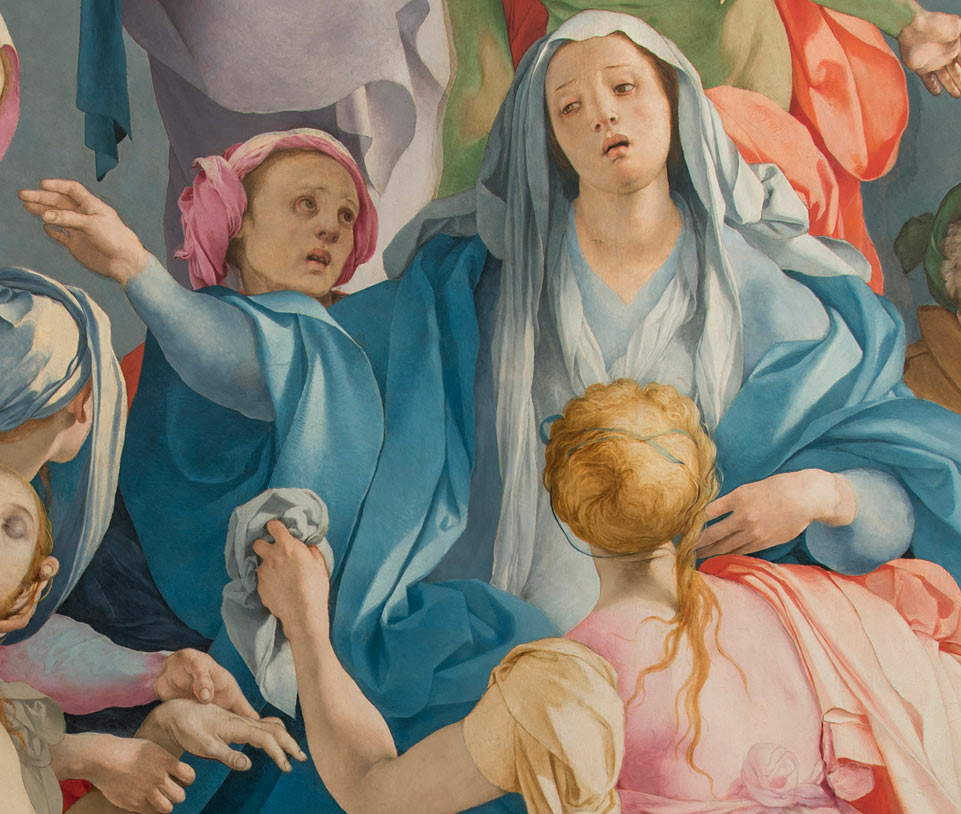


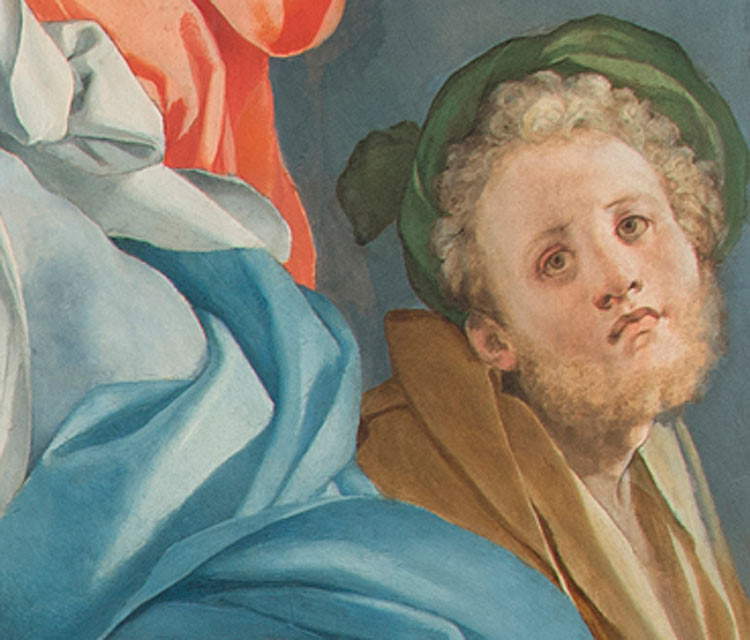
Pontormo’s Deposition marks a clear break with regard to tradition, where by tradition one must mean, as Gigetta Dalli Regoli has written, not “this or that artist,” but “certain modes of image construction widely shared in the past and thus becoming a codified system.” It is clear that the hallucinated Capponi Chapel altarpiece is situated at a clear distance from the experiences that preceded it: the figures, elongated, are crowded together without any clear understanding of spatial references; the bodies, accomplice also to the almost total absence of chiaroscuro already noted by Vasari, take on an unusual lightness, almost as if Pontormo wished to challenge nature itself; the same acid, livid, and muted colors move away from any attempt at verisimilitude, giving the characters a further unreal aspect. Pontormo then introduced further innovations that would become, beginning in the 1930s, a constant in his art: “the marked bringing of the image closer to the observer,” writes Dalli Regoli, “the renunciation of supporting scaffolding, of forms of reframing, sometimes even of the posing plane, the indifference to the problem of identifying the subject.” with the result being “an obsessive concentration on the human figure, seen both as a body, i.e., as a structure to be flexed, expanded and compressed (i.e., re-created) within a given space, and as a tangle of emotions and feelings inextricably linked to the physicality of the characters.” Another of the elements often stressed by critics are precisely the feelings on the characters’ faces: they express astonishment, dismay, disbelief, bewilderment, fear. And this pathos is heightened by the insubstantiality of the bodies, the absence of references, and the sense of artificial abstractness that the composition communicates: it is as if Pontormo were denying the values of the Renaissance.
Argan had declared that Pontormo’s art (and that of Rosso Fiorentino) is “pure nonconformism,” it is an art that establishes that “life itself is problem, a problem whose solution lies beyond life itself, in death.” A restless, tormented art, also fueled by the feeling of alienation experienced firsthand by Pontormo, a bizarre and extravagant “brain” as Vasari himself had dubbed him (and the use of the metonymy of the brain is indicative of how Pontormo’s art is first and foremost a purely mental product). What were the foundations on which Pontormo had been able to build such an innovative and radical image? What were the sources from which he had drawn?
The first and most direct reference is to the Vatican Pieta by Michelangelo Buonarroti (Caprese, 1475 - Rome, 1564), as already noted by Leo Steinberg, who, in an essay published in The Art Bulletin in 1974, compared the body of Christ carried by the two angels in Michelangelo’s Deposition with that of the Pieta, noting, moreover, a not insignificant detail, namely, the change of dedication of the Capponi chapel desired by Ludovico, who transferred it from the Annunciation to the Pietà, a theme more congenial to the funerary destination of the setting, which was to be the family’s burial place. “The allusion in the altarpiece is precise and specific,” Steinberg writes: “Pontormo was evoking Michelangelo’s marble group in St. Peter’s. Only Michelangelo’s figure of Christ anticipates the twisting of Pontormo’s Christ. The sinuous arabesque that the dead body depicts in Michelangelo’s marble is, as in Pontormo, a three-dimensional curve, bending both at the height of the groin and at the height of the chest and, at the same time, bending to embrace the Virgin, so that the right side, the wounded one, arches fully.” The reference to Michelangelo, according to Steinberg, is not only a matter of form (moreover, it will be noted how even the colors refer back to the Michelangelo of the Sistine Chapel vault): Pontormo, with his Deposition, intended to create a sort of “separate Pietà,” he wanted to condense into a single image the moment of Christ’s transportation to the tomb and the Virgin’s mourning. An intention further made explicit by the preparatory drawing preserved in Oxford, where in the space reserved for the cloud in the final drafting we notice instead a staircase, evoking the Deposition, to insert another moment of the narrative, to construct a story divided into three moments (the Deposition, the Pieta and the Separation). The reasons for the insertion of the cloud, according to Steinberg, rest on a change in the artist’s idea: “in its final realization, it would still have symbolized an event in three stages, but with a thematic change that places the removal of the dead body not in the final stage, but in the middle of the action” (the golden light that invests the cloud in fact prefigures the moment after Christ’s death). The “Separate Pieta” theme would then find further correspondence in the characters’ faces, which echo the grief of Christ’s mother.
John Shearman, on the other hand, has insisted on the Deposition ’s possible dependence on Raphael’s counterpart painting, the Deposition executed for the church of San Francesco al Prato in Perugia and now in the Galleria Borghese in Rome. If Raphael’s altarpiece can be read as a Transportation of Christ to the Sepulcher, the same could be said for Pontormo’s altarpiece: Shearman says it is “beyond doubt” that the Empolese artist was familiar with Raphael’s precedent, since Pontormo himself drew a sketch of it. Pontormo’s work constituted “an extraordinarily imaginative renewal of the typological tradition to which he belonged,” Shearman writes, “enlivened precisely by the new recourse to those classical reliefs that had been assimilated in his immediate model, Raphael’s altarpiece of 1507.” The scholar notes that another novelty introduced by Pontormo lies in the fact that, although both he and Raphael decided to situate “the viewer in the field of action,” the viewer of the Deposition of Santa Felicita “finds himself placed in the space into which one of the two groups will shortly move to lay the body in the tomb.” That is, in the space of the altar, “where the sacrifice is repeated at every celebration of mass.” In Pontormo’s painting, it is “clear that Christ is being taken to a tomb placed in the space of the viewer, but it remains in question whether He will take the place of the Eucharist on the altar, or whether we must imagine the actual burial chamber as His destination.” The probable absence of the figure of Joseph of Arimathea in the painting would thus be explained by the fact that he is on this side of the table, in the space of the burial chamber, where Christ is about to be laid. Indeed, many have questioned the identification of the two bearers of Christ, described above as probable angels: indeed, their youthful and androgynous appearance clashes with the traditional descriptions of Nicodemus and Joseph of Arimathea.


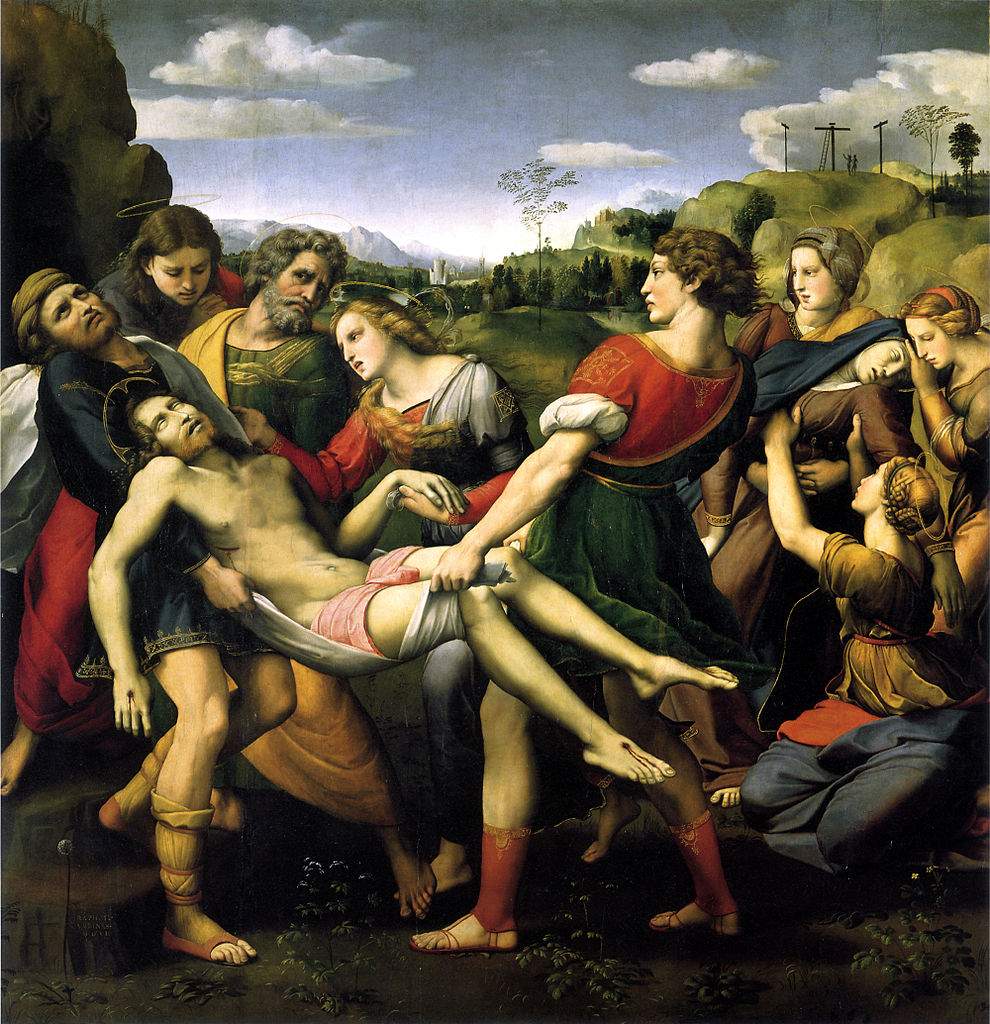
What Shearman calls “osmosis between the space of the painting and the real space” has provided the basis for an interpretation, that of Antonio Natali, which identifies the offering of Christ’s body as panis angelicus, “bread of the angels,” recalling the sacrament of the Eucharist. This is a reading that places the Deposition in line with works such as Andrea del Sarto’s Luco altarpiece, in which similar meditations can be read: “the redeeming grace of Christ who, deposed by the angels on the altar as a living offering of flesh and blood destined to be renewed daily in the Eucharistic sacrifice,” wrote Andrea Baldinotti reflecting on Natali’s hypothesis, “operated the completion of the promise made by God to his people, now unfolded in Santa Felicita with crystalline clarity, through the alpha and omega of the Savior’s earthly vicissitude: his incarnation in Mary’s womb and his descent into the tomb after the scandal of the cross.” It was therefore also a kind of political manifesto (as was the Pieta of Luco) that intervened at a time when Lutherans denied the theological concept of transubstantiation, that is, the actual conversion of the substance of bread into the substance of Christ’s body, and of the substance of wine into the substance of Christ’s blood, which according to Catholic doctrine occurs during every Eucharistic celebration. Compared to Andrea del Sarto, Pontormo would have wanted, according to Natali, to make explicit the offering of Christ as panis angelicus. The chapel’s stained-glass window, the work of Guillaume de Marcillat, who had already depicted the scene of Christ’s transport to the tomb in the room’s window, is called into question as proof. “The assertive clarity with which Jacopo decided dinvolved in the mystery of Christ’s redemptive death,” Baldinotti concludes, “makes his masterpiece reveal itself not only as the climax of the story of salvation to God the Father and the biblical patriarchs of the vault does, in fact, echoes the theme of the Incarnation proposed by theAnnunciation and the Madonna and Child below but also aintima meditation charged with important reflections on the Florentine Counter-Reformation painting of the second half of the century around the tangible beauty of a divine body that not even the death of the cross was able to dim.”
Pontormo’s anti-Classicism has often been likened to that of Albrecht Dürer, who may have impressed him and Rosso, wrote Maria Fossi Todorov, for the “novelty of his inventions,” for his “unusual iconographies,” for his “unconventional compositional solutions, so apt to express their bizarre and visionary reveries.” These were, however, cues that were “absorbed and relived in an entirely different climate, which radically transformed their first meaning.” if, however, more punctual echoes appear in some works such as the Deposition of the Certosa del Galluzzo, which finds references in Dürer’s Burial of the Little Passion, less stringent seem to be the case for the Deposition of Santa Felicita (for the body of Christ, for example, Pontormo’s Deposition has been likened to Dürer’s 1511 Gnadenstuhl ), which nevertheless also finds other iconographic models. See, for example, the gesture of the woman holding the head of Jesus: it finds correspondences in Perugino’s Lamentation over the Dead Christ preserved in the Palazzo Pitti, as well as in Botticelli’s Lamentation now at the Poldi Pezzoli in Milan.
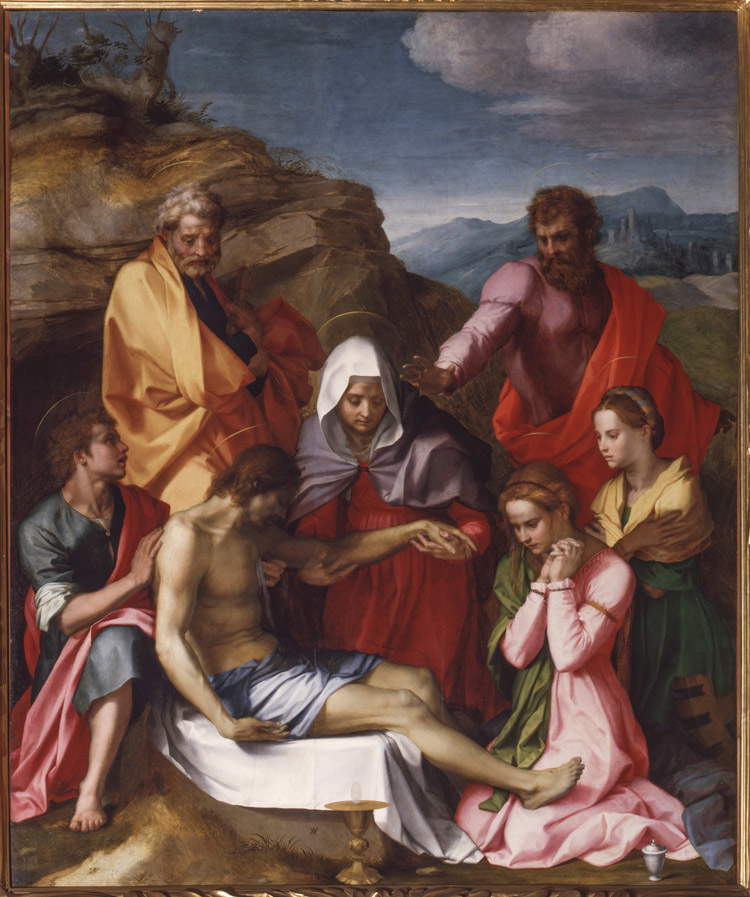
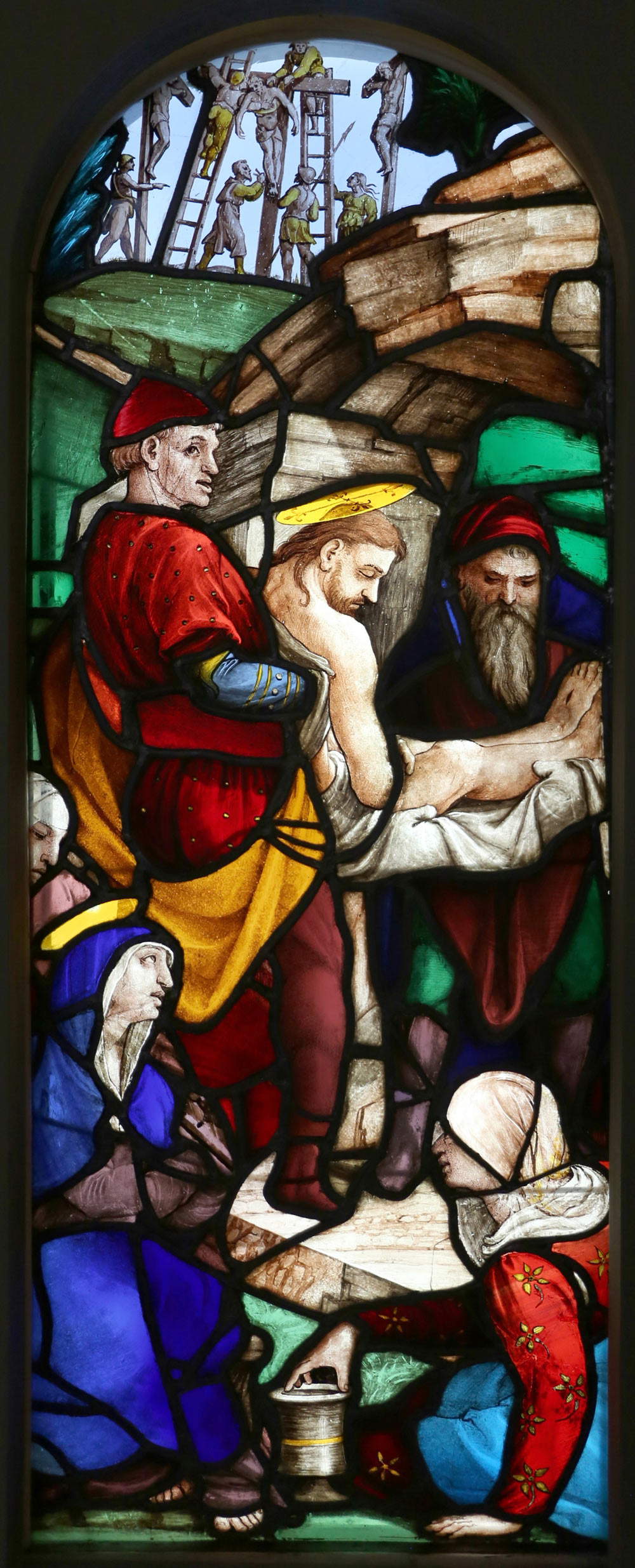

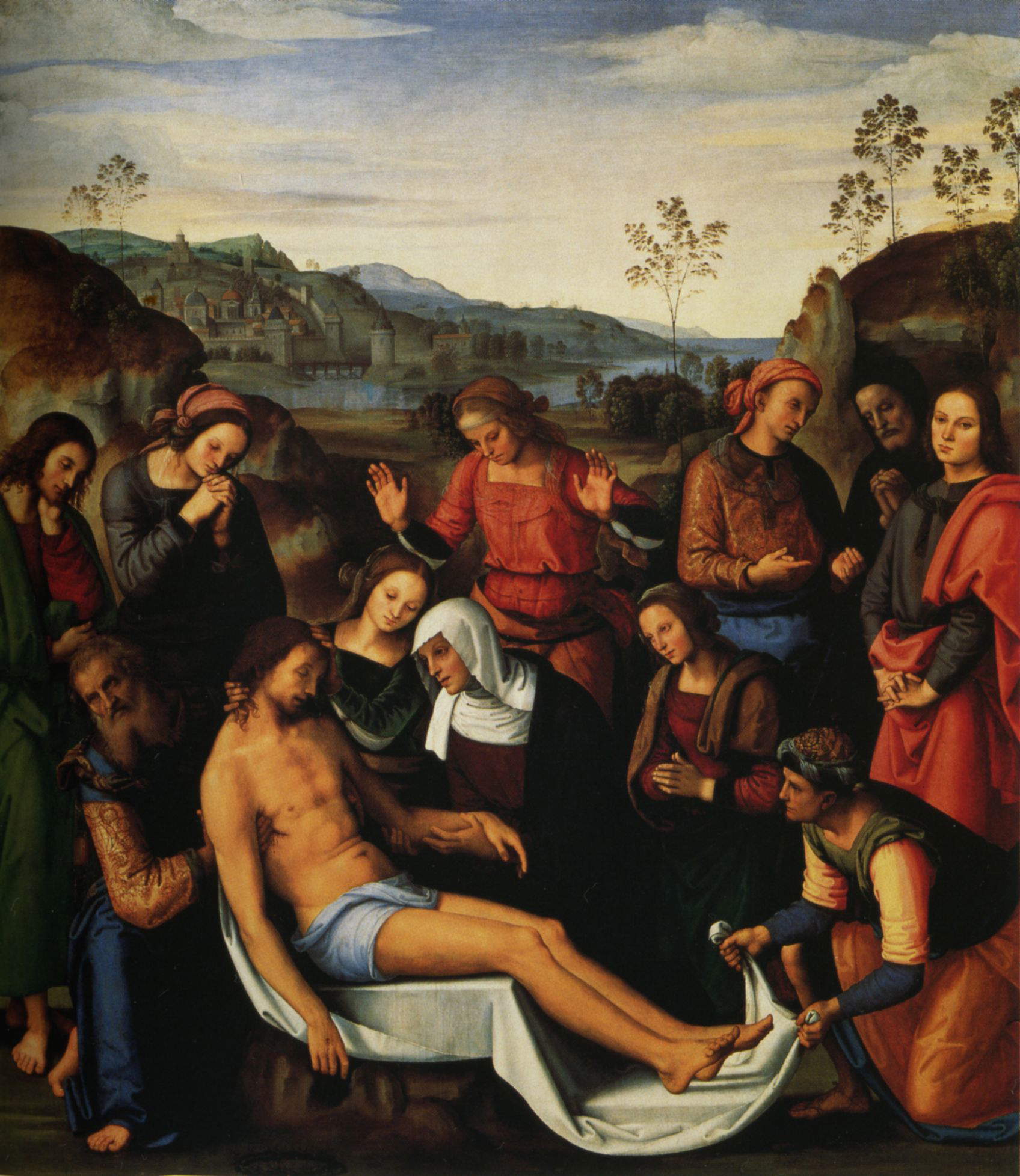
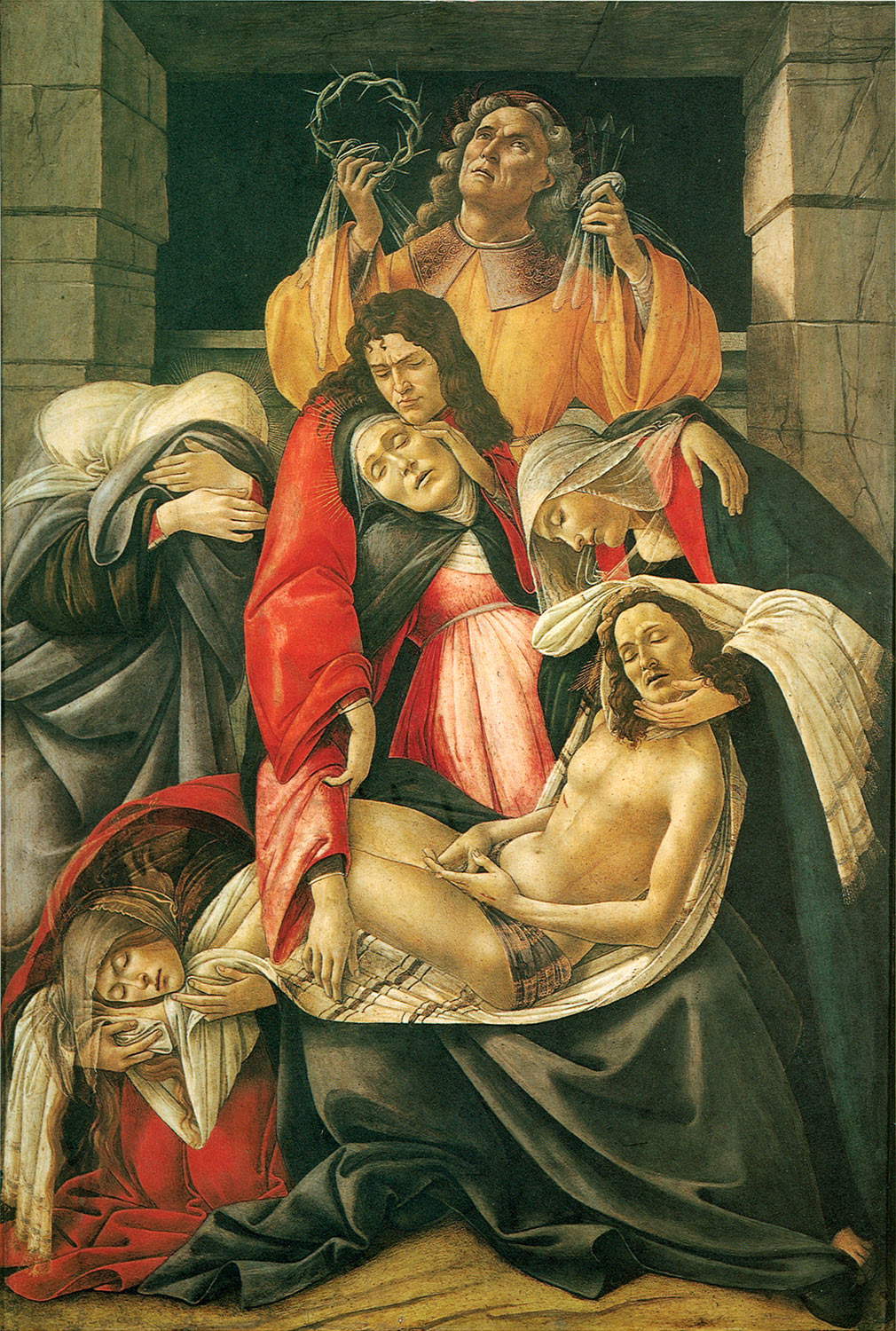
Finally, the restoration to which the work was subjected in 2017, on the occasion of the exhibition The Sixteenth Century in Florence. “Modern Mannerism” and Counter-Reformation held in Florence at Palazzo Strozzi. The intervention was handled by restorer Daniele Rossi, who first subjected the work to scientific investigations that shed light on the previous interventions (retouches had been detected on the faces and robes, as well as overlapping layers of varnish: the retouches had become necessary due to alterations caused by the fire of the altar candles), on the preparatory drawing (the greatest repentances were noted on the feet of the figure supporting Christ, and on the face of Jesus: the feet of the figures in particular are the parts on which Pontormo struggled the most, “a sign perhaps that the painter,” Rossi wrote, “was looking for the perfect balance of the bodies in every slightest articulation in a work of strong dynamism, in continuous circular movement”) and on the wooden support, judged to be of exceptional quality, such that it still retains a formidable flatness five centuries later.
The intervention, which also included a delicate cleaning to remove yellowed varnishes, focused mainly on the ancient retouches, with removals of the repainting, and on the few lifts that the pictorial film showed. The cleaning made it possible to recover Pontormo’s original colors: “the hues used,” wrote Daniele Rossi, “are so clear, so similar in intensity, that the parts in full light are barely distinguishable from those barely in shadow and these from those fully in shadow.” The surface’s so luminous appearance is also due to the fact that Pontormo mixed most of the mineral colors with white lead, a white pigment consisting of basic lead carbonate: this expedient gives this particular effect to the colors.
Today, therefore, it is possible to admire Pontormo’s Deposition as a 16th-century Florentine probably could have seen it. Still in the church for which it was made, in the chapel purchased by the patron a few years earlier, in its frame. There are not many great masterpieces of art history that can still be seen in their context: and to think that the church of Santa Felicita, in the Oltrarno district, often goes unnoticed, neglected by the thousands of tourists who move every day along the axis that from the Uffizi crosses Ponte Vecchio and leads toward Palazzo Pitti and the Boboli Gardens. Pontormo’s masterpiece is there, just past the bridge, made available free of charge (and one really well and repeatedly spends pocket change to enjoy a few minutes of illumination, essential to see Pontormo’s true colors shine through). But it is generally seen by few. For those who see the Deposition for the first time, Pontormo’s altarpiece is as much a revelation as Clapp experienced when he rediscovered it more than a hundred years ago. And it is an essential stop on a trip to Florence. For those already familiar with it, however, a visit to Santa Felicita to admire it is always a welcome return.
Warning: the translation into English of the original Italian article was created using automatic tools. We undertake to review all articles, but we do not guarantee the total absence of inaccuracies in the translation due to the program. You can find the original by clicking on the ITA button. If you find any mistake,please contact us.